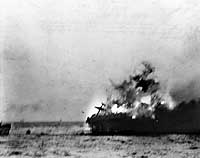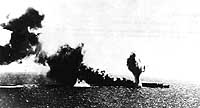Battle of the Coral Sea: Difference between revisions
imported>Howard C. Berkowitz (New page: The first battle between forces led by aircraft carriers, in which the ships never saw one another, the '''Battle of the Coral Sea''' took place on 7-8 May 1942, in the waters southwe...) |
imported>Howard C. Berkowitz No edit summary |
||
| Line 1: | Line 1: | ||
{{subpages}} | |||
The first battle between forces led by [[aircraft carrier]]s, in which the ships never saw one another, the '''Battle of the Coral Sea''' took place on 7-8 May 1942, in the waters southwest of the [[Solomon Islands]] and eastward from [[New Guinea]]. While the [[U.S. Navy]] lost more tonnage than the [[Imperial Japanese Navy]], the battle is considered a strategic victory for the U.S., because it caused, for the first time, a Japanese invasion fleet to turn back. Targeted for [[amphibious warfare|amphibious landings]] were [[Tulagi]] and [[Port Moresby]]. A second strategic effect was reducing the Japanese resources available for the [[Battle of Midway]], approximately a month later. <ref name=NHC>{{citation | The first battle between forces led by [[aircraft carrier]]s, in which the ships never saw one another, the '''Battle of the Coral Sea''' took place on 7-8 May 1942, in the waters southwest of the [[Solomon Islands]] and eastward from [[New Guinea]]. While the [[U.S. Navy]] lost more tonnage than the [[Imperial Japanese Navy]], the battle is considered a strategic victory for the U.S., because it caused, for the first time, a Japanese invasion fleet to turn back. Targeted for [[amphibious warfare|amphibious landings]] were [[Tulagi]] and [[Port Moresby]]. A second strategic effect was reducing the Japanese resources available for the [[Battle of Midway]], approximately a month later. <ref name=NHC>{{citation | ||
| url = http://www.history.navy.mil/photos/events/wwii-pac/coralsea/coralsea.htm | | url = http://www.history.navy.mil/photos/events/wwii-pac/coralsea/coralsea.htm | ||
Revision as of 12:36, 18 February 2009
The first battle between forces led by aircraft carriers, in which the ships never saw one another, the Battle of the Coral Sea took place on 7-8 May 1942, in the waters southwest of the Solomon Islands and eastward from New Guinea. While the U.S. Navy lost more tonnage than the Imperial Japanese Navy, the battle is considered a strategic victory for the U.S., because it caused, for the first time, a Japanese invasion fleet to turn back. Targeted for amphibious landings were Tulagi and Port Moresby. A second strategic effect was reducing the Japanese resources available for the Battle of Midway, approximately a month later. [1]
The U.S. unit, Task Force 17 (RADM Frank Fletcher, United States Navy), built around USS Lexington (CV-2) and USS Yorktown (CV-5), lost the Lexington and two destroyers. In support, but not taking part in the main battle, was Task Force 44 (RADM John Crace, Royal Australian Navy).[2]
Close-in Japanese airpower would be provided by land-based airpower from bases to the north and by two naval forces containing a small aircraft carrier, IJN Shoho, several cruisers, seaplane tenders and gunboats. More distant cover would be provided by the fleet containing the aircraft carriers IJN Shokaku and IJN Zuikaku and escorts. VADM Takeo Tagaki was in overall command.
Shokaku was seriously damaged, and, while Zuikaku was not heavily hit, she had to spend six weeks obtaining new aircraft and pilots. Neither were able to participate in the Battle of Midway. Midway, usually considered the turning point of the Pacific War, was a very close battle; had the six carriers of the Mobile Striking Fleet that were at the Battle of Pearl Harbor were present, rather than the four that were used, the outcome could have been very different. [3]
References
- ↑ Battle of the Coral Sea, 7-8 May 1942 -- Overview and Special Image Selection, Naval Historical Center, United States Navy
- ↑ Oceania: The Battle of the Coral Sea, Jane's Oceania
- ↑ Battle of the Coral Sea (May 7-8, 1942), Imperial Japanese Navy Site

